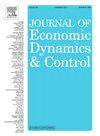非高斯收入风险下的消费动态和福利
IF 2.3
3区 经济学
Q2 ECONOMICS
引用次数: 0
摘要
最近的实证研究表明,收入变化的分布严重偏离对数正态性:特别是,收入变化呈负偏态,峰度极高(尾部又长又粗),而且这些非高斯特征在生命周期内和个人收入水平上都有很大的不同。此外,收入变化还表现出非线性(非对称)均值回归。在本文中,我们在生命周期消费储蓄模型中嵌入了一个非常丰富的 "基准收入过程",以捕捉这些非高斯和非线性特征,并研究其对消费动态、消费保险和福利的影响。我们展示了四个主要结果。首先,基准过程与经验中的终生收入不平等--消费不平等的一阶替代变量--基本吻合,而典型高斯(持续加过渡)过程则低估了五到十倍。其次,基准过程所隐含的特异风险福利成本是典型高斯过程的 2 到 4 倍。第三,文献中衡量收入冲击对消费的传递的标准方法,可能会大大夸大非高斯冲击下的消费平滑程度。第四,在非高斯收入风险下,从过渡性收入(如刺激支票)中消费的边际倾向更高。本文章由计算机程序翻译,如有差异,请以英文原文为准。
Consumption dynamics and welfare under non-Gaussian earnings risk
Recent empirical studies document that the distribution of earnings changes displays substantial deviations from lognormality: in particular, earnings changes are negatively skewed with extremely high kurtosis (long and thick tails), and these non-Gaussian features vary substantially both over the life cycle and with the earnings level of individuals. Furthermore, earnings changes display nonlinear (asymmetric) mean reversion. In this paper, we embed a very rich “benchmark earnings process” that captures these non-Gaussian and nonlinear features into a lifecycle consumption-saving model and study its implications for consumption dynamics, consumption insurance, and welfare. We show four main results. First, the benchmark process essentially matches the empirical lifetime earnings inequality—a first-order proxy for consumption inequality—whereas the canonical Gaussian (persistent-plus-transitory) process understates it by a factor of five to ten. Second, the welfare cost of idiosyncratic risk implied by the benchmark process is between two-to-four times higher than the canonical Gaussian one. Third, the standard method in the literature for measuring the pass-through of income shocks to consumption—can significantly overstate the degree of consumption smoothing possible under non-Gaussian shocks. Fourth, the marginal propensity to consume out of transitory income (e.g., from a stimulus check) is higher under non-Gaussian earnings risk.
求助全文
通过发布文献求助,成功后即可免费获取论文全文。
去求助
来源期刊

Journal of Economic Dynamics & Control
ECONOMICS-
CiteScore
3.10
自引率
10.50%
发文量
199
期刊介绍:
The journal provides an outlet for publication of research concerning all theoretical and empirical aspects of economic dynamics and control as well as the development and use of computational methods in economics and finance. Contributions regarding computational methods may include, but are not restricted to, artificial intelligence, databases, decision support systems, genetic algorithms, modelling languages, neural networks, numerical algorithms for optimization, control and equilibria, parallel computing and qualitative reasoning.
 求助内容:
求助内容: 应助结果提醒方式:
应助结果提醒方式:


